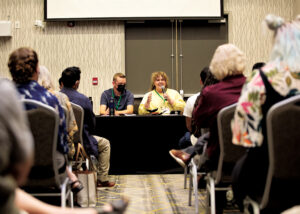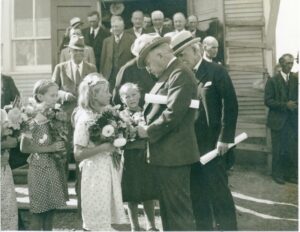Sheep, shepherds and wolves—that’s the metaphor Virgil O. Wiebe uses to describe how Mennonites have traditionally related to human rights.
Wiebe, a professor from the Faculty of Law at the University of St. Thomas in Minneapolis and immigration lawyer by profession, addressed these apparent contradictions as part of a conference exploring different ways Mennonites have experienced issues of human rights throughout the years.
The conference, Mennonites and Human Rights: Grappling with State Power in the Past and Present was held from October 18-20 at the University of Winnipeg and hosted by the university’s Mennonite Studies department.
Mennonites have been and continue to be victims of human rights abuses, beneficiaries from the human rights abuses suffered by others, and advocates for the human rights of others.
“Dirk Willems is our favourite ice-fishing hero,” says Wiebe, referencing the story of the Anabaptist martyr known for rescuing his jailer, who had fallen through the ice while Willems tried to escape from jail. “But does claiming him mean I have to claim the nasty things too?”
Wiebe contrasts the much-loved story of Dirk Willems rescuing his jailer from an icy pond with the story of Mennonites starting farms on land taken from displaced Aboriginal people.
“They (human rights advocates and human rights abusers and victims) are separate groups,” says Wiebe. “But there’s movement from one group to another, and the most interesting places are the places in between. A circle works well to draw them together.”
Stories of a Salvadoran military member turned Mennonite pastor; a Burmese refugee in the U.S. who murders his wife after fighting for years to bring her to safety; and a landmine clearance expert in the Serbian lost his arms in a mine explosion and then becomes an advocate for a global ban on the weapons are some of the examples Wiebe uses to illustrate the fluidity of human rights interactions.
A key question of the conference as put forth by Wiebe was, “What are the concepts, opportunities and pitfalls of Mennonites engaging in human rights?”
The idea for a conference exploring the links between Mennonites and Human Rights finds its roots partially in conversations surrounding the new Canadian Museum for Human Rights under construction in Winnipeg.
“It was the creation of the Canadian Museum for Human Rights that led to the creation of the community-based, inter-institutional Mennonites and Human Rights Committee about seven years ago,” explains Royden Loewen, the chair of Mennonite Studies at the University of Winnipeg.
“The committee was struck to provide a Mennonite voice to the CMHR as it was being conceptualized. Repeatedly, the message from the committee to CMHR—at one point, an official submission—was the Mennonites did not wish the CMHR to document Mennonite suffering.”
Mennonites have not traditionally used human rights language to talk about systems of justice, peace, and oppression, a key theme of the conference. With regard to the CMHR, the committee suggested that instead the museum could “provide a voice for the powerless and to seek to document not so much victimization as reconciliation.”
Melinda Enns lives in Abbotsford, British Columbia, and majored in political science at the University of the Fraser Valley. She recently completed a term with Christian Peacemaker Teams, and attended the conference in order to learn more about what a career in peace-building might look like.
“Being of Mennonite heritage, I understand peace, nonviolence, and social justice to be highly important for our world’s proper functioning, and for each person’s highest quality of life,” she says.
A highlight of the conference for Enns was gaining an “understanding of the conflicting perspectives on human rights from a Mennonite perspective.”
She recalls one speaker explaining “that historically, Mennonites have been forced to look inwards in order to engage in the struggle for the right to conscientious objection. Now, in Canada and the USA, Mennonites have been given these freedoms and are now able to move the gaze from inwards to outwards.”
The question for Enns—and the question the entire conference attempts to address—is “what does the ‘Mennonite way’ look like in this new context?”
Dr. Lloyd Axworthy, President of the University of Winnipeg and former Canadian Minister of Foreign Affairs, opened the conference by sharing the internal conflict he faced as a person of faith during the war in Kosovo.
Speakers, panelists and guests came from countries such as Russia, the Philippines, Colombia, and the USA as well as across Canada.








Leave a Reply
You must be logged in to post a comment.